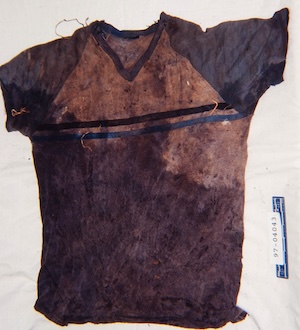Summary
In May 1997, skeletal remains were located in a field off of Haggerty Road in Plymouth, Michigan. The discovery was made in the west Detroit suburb when a man interested in purchasing the property was conducting a survey. The citizen reported coming across a piece of rolled up carpet that, when opened, revealed human skeletal remains along with several articles of clothing and jewelry. Authorities responded to the scene, and it was determined that the carpet and remains had been there for multiple years.
A death investigation was initiated, and investigators determined that the remains belonged to an adult male. It was estimated that the man was about 5’8” tall. The man’s weight was unknown but based on the size of shorts found on the body, investigators believed that the man was slim. It was determined that the man likely died due to a head injury and his death was ruled a homicide. Over the years, investigators pursued leads in hopes that the man could be identified, including investigating the origin of the gold class ring found on the man’s body, testing on the clothing and ballistics testing of a .357 slug found with the remains.
In 2015, traditional DNA testing was done and uploaded to CODIS was performed as part of the investigation into the man’s identity, but there was no match to a known individual. Details of the case were entered into NamUs as UP11420. For decades, investigators worked to identify the man including appealing to the public for any information that could be helpful. 
In 2022, investigators with the Plymouth Township Police Department teamed with Othram to determine if advanced DNA testing could help to identify the long-unidentified John Doe. Forensic evidence was submitted to Othram’s laboratory in The Woodlands, Texas where DNA was extracted from the skeletal evidence. Using Forensic-Grade Genome Sequencing®, an ultra-sensitive comprehensive DNA profile was developed. This DNA profile allowed Othram scientists to confirm that the unknown man’s ancestry was African and not Caucasian.
The DNA profile was then submitted for forensic matching allowing Othram’s in-house forensic genetic genealogy team to develop new leads about the man’s identity. These leads were provided to law enforcement, who spearheaded a follow-up investigation leading to a potential relative of the man, who provided a reference DNA sample. The potential relative's DNA profile was compared to the DNA profile developed for the unknown man using KinsSNP® Rapid Relationship Testing. This investigation led to the identification of the man as Benjamin Harrison Fountain who was born on May 6, 1926.
Fountain, who was drafted to serve in World War II, was born in Virginia and later lived in West Virginia and finally in Detroit. Had he been alive when his body was found, Fountain would have been in his 70s. An investigation into Fountain’s death continues. Anyone with information is urged to contact Plymouth Township Police by calling (734) 354-3250.
After they were found in 1997, Fountain's remains were stored at the Wayne County Medical Examiner’s Office. He was finally laid to rest, with his name, on May 16th, 2025, at Our Lady of Hope Cemetery in Brownstown, MI.
Benjamin Fountain’s identification marks the 19th publicly announced case in Michigan where authorities used technology developed by Othram to assist in identifying an individual.
